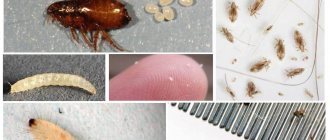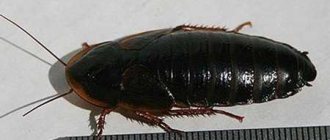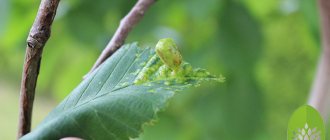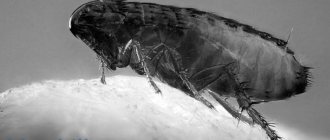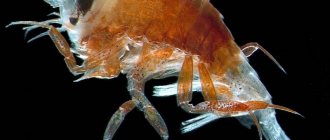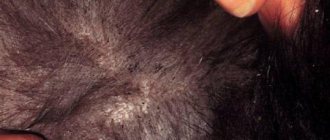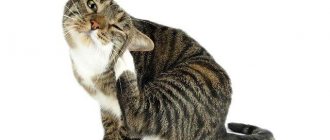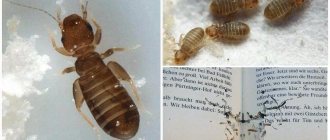No matter what the flea is called, the appearance of its inconspicuous body in various corners of the apartment is always an unpleasant surprise for the one who discovered it. Indeed, in addition to painful bites that cause severe skin reactions, these small insects are capable of carrying dangerous infectious diseases - hepatitis, tularemia, typhus, plague (we talked in more detail about the danger of fleas to human health here).
Do not also forget that fleas are very tenacious and reproduce at a tremendous speed. Therefore, at the first detection of an adult, measures should be taken immediately to destroy the parasites before they fill the entire house.
And so let’s figure out who they call bed and linen fleas.
Bed fleas: what are they?
This popular nickname was given to insects that live near humans, whose blood is the main source of nutrition for small parasites. The appearance of these pests causes a lot of inconvenience and poses a danger to the health of people and domestic animals.
Fleas are small insects, the size of an adult does not exceed 3 mm. The scientific name of these parasites is translated from ancient Greek and means “pump” and “wingless”. Linen fleas belong to the order of blood-sucking insects and cannot fly. But the lack of wings does not prevent them from moving rapidly.
The locomotor system of these insects consists of 6 limbs, the hind ones are the most powerful, thanks to them the fleas are distinguished by their jumping ability. Moving in this way, the parasites easily find a victim and attach to it with the help of bristles that cover the insect’s abdomen.
The flea's powerful hind limbs allow it to make rapid jumps.
The height of a flea's jump can reach 50 cm, and its length can be up to 1.5 meters. Small pests move quickly and are almost impossible to catch.
Who are we dealing with?
Researchers managed to describe 2086 species and 15 families of fleas. The name “bed flea” was coined by people who encountered insects in the bedroom. From a scientific point of view, this type of insect does not exist. The parasite that has settled in the bed belongs to the family of common fleas.
The insect is covered with a durable chitinous shell that cannot be damaged by simple pressure. The body is flattened laterally. The bristles and spines covering the limbs allow the flea to cling to the fur and skin of the victim. Thanks to their long hind legs and a special traction mechanism, fleas make high-speed and high jumps.
Parasites love to lay eggs not only on the pet’s fur, but also in secluded corners of the apartment. Larvae and pupae are distinguished by their vitality. They feed on decomposed organic matter (particles of dust and debris).
Why are they dangerous?
Bites are characterized by manifestations of allergies.
Feeding on the blood of humans and small animals, fleas leave painful wounds on the body that are easily distinguished from the bites of other insects.
Petechiae appear on the skin - small hemorrhages. These red spots with a dark spot in the middle are painful and very itchy.
Flea bites cause an allergic reaction, especially in children and people with sensitive skin.
Victims may experience pulicosis or sarcopsillosis. These parasitic diseases cause swelling, pain, itching, and in severe cases, damage to the nervous system.
But the main danger from bed flea bites is the transmission of infectious diseases through the blood:
- hepatitis types B and C;
- bubonic plague;
- tularemia;
- typhus;
- encephalitis;
- tuberculosis.
Fleas can reproduce quickly, rapidly increasing their population indoors, so it is necessary to immediately respond to their appearance in order to prevent the consequences of the activity.
Bed linen and mattress care
To reduce the risk of parasite reproduction, special attention should be paid to the sleeping area - there is a large accumulation of bed fleas due to the availability of food. It is important to periodically clean the mattress cover, vacuum the bed, and change bed linen regularly.
If disinsection has been carried out previously, all laundry must be washed at high temperatures. There may have been flea excrement, larvae, or dead adults in the laundry. Washing is necessary to prevent bed fleas or allergic reactions.
How to find them
Fleas can appear not only under unfavorable sanitary conditions in the room. Many people wonder where these insects come from. Maintaining cleanliness does not always save you from the invasion of blood-sucking pests.
The following factors can contribute to the spread of parasites:
- uncleaned entrance;
- unscrupulous neighbors;
- rats and mice living in the basement of buildings;
- dampness in the toilet room;
- pets.
Linen fleas do not live in beds or sofas. They live in dark corners, trash cans, behind baseboards, and on pet bedding. Here fleas have a resting place, lay eggs and shelter. Parasites climb into bed only in search of food.
You can find out about the presence of fleas in a house or apartment by the characteristic bite marks, especially on the legs. Unlike other insects, fleas do not have an anesthetic enzyme in their saliva. Their bites are painful and itchy.
It is easy to detect only dead fleas, for example, on the bedding of an animal after it has been treated.
You won't be able to see what fleas look like. These jumping parasites disappear at lightning speed. To make sure of their presence, you need to look in the house or apartment for traces of their vital activity. It is worth carefully inspecting the bed. Flea excrement in the form of small black grains of sand may remain on the mattress. The appearance of pests in a room is indicated by white hard balls that can be found in dark corners, behind cabinets, near trash cans.
Lifestyle and behavioral characteristics
Fleas can always be seen, regardless of the time of year, on the owner or in his home. The main carriers are mammals that have a nest, burrow or live in an apartment. Some types of fleas settle in nests left for a long time. Homeless animals do not have their own home, so their fleas live on their bodies all year round and breed there. Parasites suck blood, regardless of gender, from one minute to several hours. When food runs out, insects can live for a long time (months) without food, but then they attack the owner with greed.
Interesting! A flea's jump is about 100 times longer than its body length.
Chemical flea control products
If blood-sucking parasites are found in the house, it is necessary to promptly begin to destroy them. The most common way to control insects is with special chemicals. But before using them, it is necessary to thoroughly clean and ventilate the home: inspect the closet, wash the bed linen in hot water and iron the bed linen. Hanging your laundry out in the cold in winter will also help.
If you have pets, you must take them to the veterinarian. The doctor will select an effective and safe product (drops or shampoo) for them to remove fleas.
After completing these activities, you can begin the main stage of the fight - treating the apartment with insecticides. Modern chemicals will help quickly rid your home of parasites.
"Cucaracha"
A potent product of domestic production. It contains melation and cypermethrin. The drug is available in the form of gel, powder and emulsion. When used correctly, it is harmless, has a low level of toxicity, and the drug is economical and accessible. The chemical has an unpleasant odor that can persist for a long time.
It should not be used to treat children's bedrooms and hospital wards. The drug "Cucaracha" acts only on fleas and is harmless to their eggs.
"Ziper"
This insecticidal agent is intended to combat insects closely associated with human habitation (bugs, fleas, cockroaches). “Ziper” is used for sanitary treatment of residential and commercial premises, public transport, and waste accumulation. Affects all stages of insect development.
It has a long-lasting effect and remains effective under intense external influences (sunlight, rain).
The drug is safe for humans.
"Delta Zone"
A modern insecticide with a good effect on parasites, practically odorless.
This gives the Delta Zone product an advantage over other preparations for treating residential premises. The active ingredient is deltamethrin, which causes nervous paralysis in parasites.
One 50 ml bottle is enough to treat a small one-room apartment.
The Delta Zone is safe for humans. Even if accidentally ingested, it quickly disintegrates and is excreted from the body.
"Cifox"
A strong acaricidal-insecticidal agent. The main substance – cypermethrin (25%) has a paralyzing effect on insects, which die 20-30 minutes after contact with the drug.
The Zifox solution is used to disinfect not only houses and apartments, but also summer cottages. If you follow safety precautions, the product can be used independently, but it is mainly used by exterminators.
The product is safe for animals.
"Combat"
This insecticide comes in spray, gel and trap forms. It contains cyphenothrin and imiprotrin.
These substances paralyze the nervous system of parasites, which leads to their death. “Kombat” is minimally toxic; it can even be used to treat clothes and linen. After the first cleaning, the insects die.
The drug is safe for humans and pets.
Despite its effectiveness, it has a number of disadvantages:
- smells unpleasant;
- harmless to parasite eggs;
- can be removed by wet cleaning;
- high price.
To treat premises with Combat, you need to stock up on a respirator, gloves and a protective suit.
"Raid"
One of the most commonly used means of combating parasites. It is produced in the form of an aerosol and has a nerve-paralytic effect. “Raid” kills both the adult and its larva, but the drug does not immediately affect the pest eggs, so the aerosol disinfestation procedure must be repeated.
The product should be used to treat furniture, beds, carpets, floors, baseboards, walls, all cracks and openings. All windows and doors must be closed during the procedure.
After disinfestation, it is necessary to ventilate the room for at least 3 hours. The effect of "Raid" lasts for a month.
Precautions when getting rid of fleas
When dealing with domestic parasites, it is necessary to strictly adhere to precautionary measures. This will help optimize work and reduce the risks of negative consequences. By ignoring strict rules, you can cause enormous harm to your body, as well as expose your loved ones, especially children and pets, to the risk of infection.
Personal safety measures
If you are planning independent actions to combat insects, you need to pay attention to the following aspects:
- take care of protective clothing. This is especially true for chemical control methods. It is necessary to have gloves, a respirator, shoes and clothing made of thick fabrics or polyethylene;
- provide for the presence of a vacuum cleaner, broom, iron, brush, rag, bags, etc. This is necessary so that during the work everything is at hand, since leaving the room or searching for the right thing will be inconvenient;
- make sure there is adequate ventilation. This is especially necessary after chemical treatment. You should immediately check how easily the windows and doors open.
- Chemical processing agents are highly flammable. It is recommended to keep this in mind and avoid open flames. When using electrical appliances, it is necessary to check the serviceability of sockets and wires to avoid sparks.
General safety measures when there are children and animals
Particular attention should be paid to the points below if you have children and pets. Elderly people also need help and need to be taken care of:
- Decide on the choice of means. To do this, you need to familiarize yourself with the necessary information and instructions for use. It is recommended to pay attention to the timing of the procedure and assess the situation. You will have to leave the premises for some time, so you should take care in advance about who will be there and where. You may have to set up a crib and pet house in another room, since chemical disinfection takes a long time.
- At the end of processing and keeping for a certain time, it is necessary to thoroughly ventilate the room. Even if there is a slight odor, the return to the premises should be cancelled. Children's bodies and animals' bodies are particularly sensitive to toxic substances.
- Thoroughly treat with a soapy solution and soda those places that the child will come into contact with or that the animal can reach.
- When using the powder, you must make sure that neither a child nor a pet can get it.
- If there are any unspent funds left for disinfestation, they must be hidden in places inaccessible to children and animals.
Video: flea trap
Folk remedies against bed fleas
In addition to specialized chemicals, folk remedies are widely used for a comprehensive effect on pests. Fleas have a peculiarity - they cannot tolerate strong odors. By taking advantage of this weakness of insects, you can quickly survive them from your home and protect yourself and your pets from the invasion of parasites for a long time.
Strong odors will help get rid of insects.
Wormwood tincture
This plant takes root almost everywhere. Among its 400 varieties, only wormwood is the most common and useful herb. It is an excellent remedy for domestic parasites. Wormwood has a specific smell and is used to repel fleas. Insects are afraid of it and quickly leave places where they smell a bitter smell.
The fresh plant must be placed in the favorite places where pests live: under the carpet, behind the sofa, bed, closet, near the baseboards.
To protect pets, wormwood is hidden in their beds and bedding, and hung in cages.
The tincture of the plant is used to wipe the floors, especially near the front door and in the corners. A decoction of wormwood can be sprayed indoors.
Sprigs of pine needles
The smell of pine needles in the house creates not only a festive mood. With the help of thorny branches you can protect yourself from bed fleas. Pine needles and cones with their aroma will repel parasites for a long time. Using sawdust, they are placed in corners and on pet bedding.
A decoction should be made from pine branches and sprinkled in living rooms. The needles are poured into fabric bags and hung around the apartment.
Citrus
The bright, strong smell of citrus fruits repels blood-sucking parasites. The aromatic peel of lemons, oranges, limes, and grapefruits will help get rid of harmful insects. Dried crusts are laid out in places where fleas may live: behind furniture, near baseboards, behind cabinets and bedside tables.
Citrus fruits should be used with caution if there are cats in the house. Their sense of smell may be impaired by the strong smell of the aromatic peel.
Essential oils
These products have a strong odor due to the volatile substances in their composition. Essential oils are an effective natural insecticide. They do not destroy insects, but scare them away from places where pests live.
Essential oils repel fleas due to their strong aroma.
Bed fleas cannot tolerate the smell of the following oils:
- tansy;
- peppermint;
- lemongrass;
- thyme;
- wormwood;
- tea tree;
- pine trees;
- anise
Essential oils are used only to control fleas indoors. These aromatic products should not be used on pets. They can lick oil from their fur and become poisoned.
To prepare a solution for treating a room, add a few drops of the product to water and spray it. Caution is advised for people with asthma and allergies.
Tar soap
Tar is a natural antiseptic that helps fight pathogenic bacteria and fungi. The phenol contained in birch tar is toxic to the nervous system of blood-sucking parasites.
Pet hair is treated with tar soap. Use a soapy solution to wash floors, especially in hard-to-reach places. Thanks to its antiseptic effect, tar soap not only gets rid of fleas, but also promotes the speedy healing of bites.
Getting rid of fleas on pets
Pets suffer from annoying flea bites even more than their owners. The parasites overwhelm the helpless animal, which is unable to get rid of them on its own. If even one insect remains on the fur, there will be no peace for all the inhabitants of the house. Shampoos, sprays, drops and collars are used to fight. Each product has its pros and cons, so before use you should consult a veterinarian, read information on the Internet, and also study the instructions:
- shampoo will help get rid of annoying fleas in one session. It is necessary to carefully read the instructions and monitor your pet’s behavior after using the drug. The process requires an individual approach, since the product can cause allergies in the animal. The downside is the lack of protection from relapse. If there is an external flea source, the insect may settle on the fur soon after washing. Therefore, it is recommended to “take baths” once a month in the summer, and once every three months in the winter;
Shampoos instantly relieve pets of fleas, but there is a possibility of recurrence - The spray kills fleas the first time. After treatment, you can not be afraid of a relapse for a long time, since parasites are afraid of a specific smell and sense it from a distance. The difficulty is in applying the product to the surface of the skin. Firstly, animals do not like such procedures. Secondly, the product can cause allergies or nervous disorders in your pet. Therefore, it is recommended to carefully read the contraindications in the instructions and pay attention to the behavior of the animal. If your pet reacts negatively to the product, you should choose another method;
Most often, sprays are applied to the animal’s withers, where it cannot reach with its tongue. - a collar is an effective measure, since insects react to the smell and do not approach the animal. A well-chosen collar will serve as reliable protection. But if its size is not chosen correctly, the consequences can be disastrous. A small headband will put too much pressure on the animal’s neck, making it difficult to breathe freely, leaving wounds and wearing away the fur. Large - will provoke a situation in which the pet can get caught on a sharp object. The pet itself can also react negatively to the smell of the collar - there are cases where poisoning occurred in animals wearing a collar. Therefore, this choice should be taken as responsibly as possible;
Collars can be both effective and dangerous. - Drops are the most harmless and effective method and are the most convenient. It is enough to apply a few drops to the withers, and your beloved pet will be freed from pests. The only condition is to carefully study the instructions and observe the animal’s reaction after using the drug.
All of the above remedies will be effective if they are used in combination with other methods. That is why it is recommended to follow the step-by-step instructions below:
- Treat the room where fleas live using chemical or folk remedies. Allow the required time to ensure the absence of not only living insects, but also their larvae. Do not allow animals into the treated area.
- Carefully treat the animal's habitat (rug, house, basket, etc.). It is advisable to boil the textile item in a soapy solution or wash it in a machine at high temperature. If the house is large, it must be treated along with general disinfection. The final point can be steaming with an iron.
- Treat the animal using the chosen method. After washing, let the wool dry naturally. Then it is recommended to carefully comb out the remaining insects with a special brush or glove.
During the necessary procedures, it is worth giving the pet the maximum amount of attention, because a temporary refusal from its usual place and a set of measures to care for its body are a huge stress for the pet - Once you are convinced of the final victory over the parasites, you can allow the animal into its usual habitat.
Room treatment
To clean the room from blood-sucking pests, it is necessary to carry out a general cleaning of the room. It is necessary to clear the walls and floors of carpets and furniture and clean them thoroughly. Collect and throw away all trash.
Treatment is carried out after general cleaning of the premises.
Treat the room with chemicals, especially at the joints of the floor and baseboards, near the furniture. Close the room for 2-3 hours for the drugs to take effect. After disinsection, thoroughly ventilate the room.
Why do fleas appear in bed?
First, the insect enters the home. For this, an intermediate link is needed.
- Pets walking outside;
- Basements;
- Human clothing and footwear;
- Neighbor's apartment;
- Open doors and windows in hot weather.
The parasite then finds a place suitable for living, feeding and reproducing. There are three reasons why fleas are attracted to human beds.
- Food source. A sleeping person practically does not react to bites. He lies quietly in bed, so the bed flea calmly drinks blood.
- Favorable place for laying eggs. Insects usually choose fleecy surfaces for such purposes. First, the eggs reliably stick to the bed linen and mattress, and then the resulting larvae and pupae feed on particles of the epidermis.
- Safety. During cleaning, a person carefully vacuums carpets, washes floors and baseboards, and wipes away dust. But he forgets to shake the mattress and clean the inside of the bed frame. Fleas calmly continue to live and reproduce.
Parasites love stale, damp bedding, garbage and dust under the bed.
Tips for choosing a disinfection service
The most reliable method of getting rid of bed fleas is the help of a professional disinfection service.
Specialists will quickly deal with parasites. This will save time and eliminate the need for contact with insecticides.
When choosing a disinfection service, you should pay attention to:
- The drugs used by the organization must be safe for humans and animals.
- The time for the procedure is chosen by the customer, not the company.
- The service clients are explained in detail the disinfection process, the chemicals used, and safety measures.
- Conscientious organizations work without prepayment.
- If the cleaning is unsuccessful, the customer does not pay for this event.
Services whose employees care about their reputation provide quality services, after which they receive only positive reviews.
How to recognize flea bites and how to treat wounds
It’s hard not to notice that there is a similar problem and here’s why:
- The fact that it is a flea biting can be understood immediately, since the bite is quite painful, accompanied by unbearable itching. The reason is that the flea does not secrete a special anesthetic secretion, compared to other blood-sucking parasites.
- Often from red, small spots with hemorrhage, which includes from 3 to 5 or more points.
- The body instantly reacts to the attack of this insect.
- A sign that it is a flea bite is a sharp pain at the site of the bite.
- After an insect bite, toxins enter the human body through the small wound that appears and are carried by the circulatory system. The reaction to a harmful substance can be unpredictable. If the flea is infected with some serious disease, then the person will be unlucky and the result of the bite may be hospitalization.
- Catching an insect is not so easy, because after a bite it leaves the area very quickly. But sometimes you can get lucky and the insect can simply be crushed with your fingernails.
- After some time, the itching and redness disappear and only barely noticeable dark spots remain on the skin. If this area is not combed, then in a couple of days they will disappear forever.
Pain and itching can be minimized by using:
- Use alcohol or soapy water to wipe the affected areas.
- Ice cubes, applying them to the bite sites, first wrapping them in cloth or gauze.
- Ointments or gels, such as “Fenistil” or “Rescuer”, which have an analgesic or antiseptic effect.
In some cases, you will have to see a doctor. For example:
- Increased body temperature.
- Difficulty breathing.
- Diarrhea.
- The appearance of a headache.
- Inflammation of the lymph nodes.
- Increased nervousness and agitation.
Preventing fleas
Prevention will help prevent an unpleasant neighborhood and protect yourself and your pets from pest invasion.
Compliance with the following rules will eliminate the appearance of insects:
- Maintain cleanliness in the linen closet at all times.
- Regularly treat carpets and upholstered furniture.
- Ventilate and dry pillows, blankets, and mattresses in the fresh air.
- Use high temperatures to wash and iron clothes.
- Dry-clean your outerwear periodically.
- Choose a flea collar for pets.
- When cleaning premises, do not miss hard-to-reach places.
- Avoid accumulation of garbage in the apartment.
By adhering to these rules, you can protect yourself and your home from bed fleas and other blood-sucking pests.
Consequences
The least damage caused by insects is red dots, swelling, and discomfort resulting from parasite bites. If the wounds are not treated and combed, there is a risk of infection; the scratched areas may fester.
There is a risk of inflammation of the lymph nodes, allergies, and anaphylactic shock. If negative symptoms appear, it is recommended to consult a doctor. The most serious danger from fleas is that they carry diseases:
- Anthrax.
- Typhus.
- Trypanosomiasis.
- Tularemia.
- Salmonellosis.
- Listeriosis.
- Encephalitis.
- Plague.
To avoid the occurrence of life-threatening infections, it is necessary to carry out sanitary treatment if harmful bed parasites appear in the house.
Knowing how to get rid of bed fleas, you can prevent their reproduction in a short time and protect yourself from existing fleas. Carrying out measures to get rid of insects will avoid negative consequences.
Fleas, characteristics, varieties, photos
The flea is a wingless insect with a complete metamorphosis, which implies a developmental stage consisting of three parts, namely: the egg from which the larva emerges, then the cocoon from which the pupa emerges and the last stage of transformation, from the pupa to the adult. This knowledge gives us the opportunity to recognize and exterminate the parasite at all stages of its development; often, when faced with this problem, due to incompetence, fleas can be confused with a type of insect such as bedbugs. In this case, further methods of extermination may not be suitable. Therefore, in order to avoid wasting time, we advise you, at the first stage, to familiarize yourself with the signs that will allow you to determine the type of parasite and, accordingly, choose the right method for its extermination.
The most common types of fleas
Feline
According to its main characteristics, it is similar to the dog and human flea; it is a carrier of infections such as plague and brucellosis. In most cases, it is this species that usually attacks city residents, and although the main habitat is the skin of the feline class, they can also live on humans.
Doggystyle
It is one of the most common types. According to its main characteristics, it is similar to the cat and human flea, but mainly lives on the body of dogs; in their fur or bedding, it is also a carrier of various infectious pathogens.
Human
The most common type of flea, it lives in places where humans exist, but can also live on the skin of domestic animals if they are present. The distinctive feature of the human flea is its appearance - it does not have teeth on its body and head, characteristic of other species. The human flea can carry the flea pathogen and is also the causative agent of itchy skin.
Bedding (or linen)
A typical insect with a characteristic appearance. There is no official concept or specific definition of a 'bed flea'; most often the insects that live in bed linen are either cat, dog or human. The discovery of fleas in beds or bedding may be due to a large amount of hair from your pets in these places or the accumulation of any amount of garbage, as well as due to a long period of lack of ventilation.
You need to understand
that regardless of the type of fleas, such as “dog” or “cat” fleas. Even if you don’t have pets, you can find absolutely any type of parasite in your home.
Basement
Also a collective name for the main types of fleas. Despite the fact that the main habitat of this species is basements, it can easily take root in apartment premises, especially if the housing is located in an underground, semi-underground or basement floor, and this species is often found in summer cottages or in the presence of a cellar.
Zemlyannaya
This type of flea is characterized by the fact that it chooses moist, warm places for its habitat. If we talk about an apartment, then such a place in your house will be the bathroom or similar places with high moisture and heat, and this type is also common on land, so it is more common among people engaged in some type of farming, etc. Another characteristic difference from all other similar species is that you can find bites from “ground” fleas on yourself mainly in the area.
Ways to enter the apartment
Most often, fleas attack apartments on the first and last floors of houses, coming from basements and attics. Further settlement occurs through cracks and ventilation shafts. Fleas can enter the home through pets and on clothing.
You can find out what to do if your hamster has fleas.
In order to remove bed fleas, you probably need to repeat the treatment after a few weeks.
Ways to fight
Before you start fighting parasites, you should remove them from your pets. Since through them they can also penetrate into the room. If you treat the rooms, but at least 1-2 fleas live on the animal, the result will be short-lived.
Treat animals with one of the following:
- drops. Stronghold, Frontline, Hartz products have proven themselves well;
- special insectoacaricidal sprays, for example, Bars, BlochNet, Frontline, Hartz;
- shampoos: Celandine, Mr.Bruno, Beaphar. They are especially often used for cats and dogs of decorative breeds.
After flea treatment, put a special collar on your pet to prevent re-infestation.
